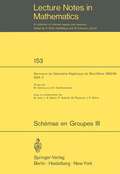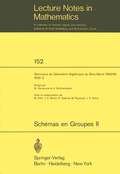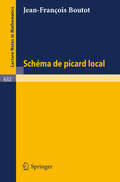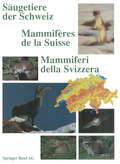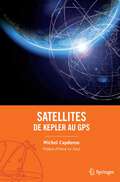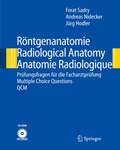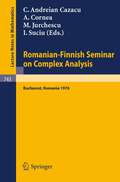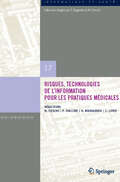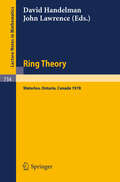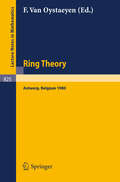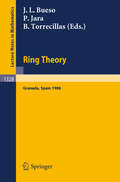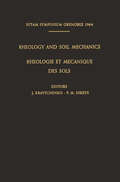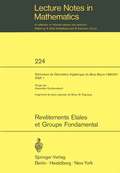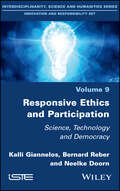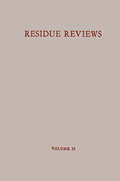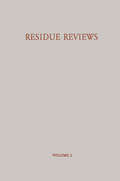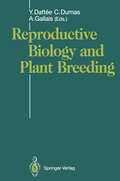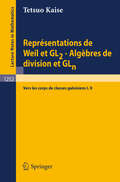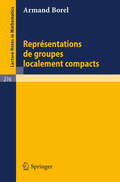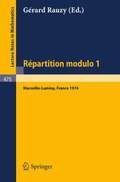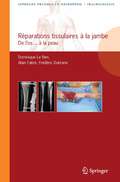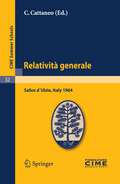- Table View
- List View
Schemas en Groupes. Seminaire de Geometrie Algebrique du Bois Marie 1962/64: III: Structure des Schemas en Groupes Reductifs (Lecture Notes in Mathematics #153)
by M. ArtinSchemas en Groupes. Seminaire de Geometrie Algebrique du Bois Marie 1962/64: II: Groupes de Type Multiplicatif, et Structure des Schemas en Groupes Generaux (Lecture Notes in Mathematics #152)
by M. ArtinSäugetiere der Schweiz / Mammifères de la Suisse / Mammiferi della Svizzera: Verbreitung · Biologie · Ökologie / Répartition · Biologie · Ecologie / Distribuzione · Biologia · Ecologia (Denkschriften der schweizerischen Naturforschenden Gesellschaft #103)
by Denkschriftenkommission Denkschriftenkommission DerSatellites: De Kepler Au Gps
by Michel CapderouCe livre expose les équations de la mécanique spatiale qui permettent de bien appréhender le mouvement orbital des satellites. De nombreux exemples éclairent cet aspect théorique. Il se poursuit par un panorama des multiples applications de l’outil satellitaire, qu’on le mobilise pour une utilisation directe (observation de la Terre ou d'autres planètes, communications, positionnement GPS, etc.) ou de très vastes projets comme l'évaluation du changement climatique.
Röntgenanatomie/Radiological Anatomy/Anatomie Radiologique: Prüfungsfragen für die Facharztprüfung/Multiple Choice Questions/QCM
by Forat Sadry Andreas NideckerEine Sammlung von 100 illustrierten Fällen der radiologischen Anatomie als Multiple Choice Fragen. Alle bildgebenden Methoden werden abgedeckt. Geeignet zum Lernen, Unterrichten und zur Selbstkontrolle. Die Fragen stammen aus den Schweizer Facharztprüfungen. A selection of 100 illustrated cases, including all imaging modalities, presented as multiple choice questions. Useful for learning, teaching and self evalutation of anatomy in every day practice of general radiology. The questions have been used during past examinations in radiology in Switzerland. Voici, sous forme d’un questionnaire à choix multiple, une sélection de 100 cas comprenant toutes les modalités d’imagerie diagnostique. Cette compilation s’avèrera utile pour apprendre, enseigner et pour l’évaluation personnelle de l’imagerie diagnostique. Ces questions ont été utilisées ces dernières années en Suisse pour les examens de spécialisation en radiodiagnostic.
Romanian-Finnish Seminar on Complex Analysis: Proceedings, Bucharest, Romania, June 27 - July 2, 1976 (Lecture Notes in Mathematics #743)
by C. Cazacu A. Cornea M. Jurchescu I. SuciuRisques, Technologies de l’Information pour les Pratiques Médicales: Comptes rendus des treizièmes Journées francophones d'informatique médicale, Nice, 28-30 avril 2009 (Informatique et Santé #17)
by M. Fieschi P. Staccini O. Bouhaddou C. LovisLes thèmes choisis pour ces treizièmes rencontres des JFIM sont au centre des débats sur l’amélioration continue de la qualité des prises en charge et de la continuité des soins, ainsi que de la maîtrise des risques. Les travaux présentés concernent des thématiques de recherche et de développement désormais classiques dans le domaine médical et de la santé publique : les systèmes d’information en santé, l’interopérabilité sémantique et les référentiels en santé, la représentation de la connaissance et l’aide à la décision.
Ring Theory, Waterloo 1978: Proceedings, University of Waterloo, Canada, 12-16 June, 1978 (Lecture Notes in Mathematics #734)
by D. Handelman J. LawrenceRing Theory, Antwerp 1980: Proceedings, University of Antwerp, U.I.A., Antwerp, Belgium, May 6-9, 1980 (Lecture Notes in Mathematics #825)
by F. OystaeyenRing Theory: Proceedings of a Conference held in Granada, Spain, September 1-6, 1986 (Lecture Notes in Mathematics #1328)
by Jose L. Bueso Pascual Jara Blas TorrecillasThe papers in this proceedings volume are selected research papers in different areas of ring theory, including graded rings, differential operator rings, K-theory of noetherian rings, torsion theory, regular rings, cohomology of algebras, local cohomology of noncommutative rings. The book will be important for mathematicians active in research in ring theory.
Rheology and Soil Mechanics / Rhéologie et Mécanique des Sols: Symposium Grenoble, April 1–8, 1964 / Symposium Grenoble, 1Er–8 Avril 1964 (IUTAM Symposia)
by J. Kravtchenko P. M. SirieysFor a long period Soil Mechanics has remained at the semi-empirica stage, and only a few decades ago it has shown a tendency to become a fundamental science. However, this evolution is taking place slowly; in spite of the efforts of numerous research scientists, the very complex rheological laws of soils are still not well known. Even if these laws were elucidated, it would take a long time still to deduce simple rules from them for reliable and convenient use in current practical engineer ing. In the pursuit of these distant aims - and of others more imme diate - fundamental research and applied research are very active, both in Rheology and Soil Mechanics. The complexity of the problems to be solved should incite the laboratory researchers and the engineers to a continuous collaboration. Everyone acknowledges the advantage of these connections although aware of the difficulty of realizing this wish. However, contacts are being made little by little between the repre sentatives of the different branches of Rheology and Soil Mechanics, to the great benefit of science. The bureau of the International Union of Theoretical and Applied Mechanics (IUTAM), aware of the importance of these two associat ed fields of mechanics, considered it possible to accelerate the natural and necessary processus of their interpenetration by organizing in Grenoble, from 1st to 8th April 1964 an International Symposium on Rheology and Soil Mechanics.
Revêtements Étales et Groupe Fondamental: Séminaire de Géométrie Algébrique du Bois Marie 1960/61 (SGA 1) (Lecture Notes in Mathematics #224)
by Michèle RaynaudResponsive Ethics and Participation: Science, Technology and Democracy
by Kalli Giannelos Bernard Reber Neelke DoornTaking stock of the overall confused picture that research and innovation (R&I) literature and practices offer with regard to citizen and stakeholder participation, this book provides a methodical conceptual and an empirical analysis to determine the connection between ethics and participation. Strong theoretical pillars in the fields of ethics, politics and responsible research and innovation (RRI) form the backbone of this critical approach to participation, which considers new approaches to democratic participation. Taking into account a number of participatory processes, Responsive Ethics and Participation establishes a new methodology to differentiate, classify and understand the added value of the participation of citizens and stakeholders in R&I.Participation could be considered the epitome of innovation ethics. However, its multidimensionality, its ethical and theoretical grounds and the nature of the involvement and related outcomes must be clarified at the outset, in order to reach active forms of participation. Ethical participation is required for reliable developments in science and technology, which is what this book ultimately demonstrates.
Responsive Ethics and Participation: Science, Technology and Democracy
by Kalli Giannelos Bernard Reber Neelke DoornTaking stock of the overall confused picture that research and innovation (R&I) literature and practices offer with regard to citizen and stakeholder participation, this book provides a methodical conceptual and an empirical analysis to determine the connection between ethics and participation. Strong theoretical pillars in the fields of ethics, politics and responsible research and innovation (RRI) form the backbone of this critical approach to participation, which considers new approaches to democratic participation. Taking into account a number of participatory processes, Responsive Ethics and Participation establishes a new methodology to differentiate, classify and understand the added value of the participation of citizens and stakeholders in R&I.Participation could be considered the epitome of innovation ethics. However, its multidimensionality, its ethical and theoretical grounds and the nature of the involvement and related outcomes must be clarified at the outset, in order to reach active forms of participation. Ethical participation is required for reliable developments in science and technology, which is what this book ultimately demonstrates.
Residue Reviews/Rückstandsberichte (Reviews of Environmental Contamination and Toxicology #33)
by Francis A. GuntherThat residues of pesticide and other "foreign" chemicals in food stuffs are of concern to everyone everywhere is amply attested by the reception accorded previous volumes of "Residue Reviews" and by the gratifying enthusiasm, sincerity, and efforts shown by all the in dividuals from whom manuscripts have been solicited. Despite much propaganda to the contrary, there can never be any serious question that pest-control chemicals and food-additive chemicals are essential to adequate food production, manufacture, marketing, and storage, yet without continuing surveillance and intelligent control some of those that persist in our foodstuffs could at times conceivably endanger the public health. Ensuring safety-in-use of these many chemicals is a dynamic challenge, for established ones are continually being dis placed by newly developed ones more acceptable to food tech nologists, pharmacologists, toxicologists, and changing pest-control requirements in progressive food-producing economies. These matters are of genuine concern to increasing numbers of governmental agencies and legislative bodies around the world, for some of these chemicals have resulted in a few mishaps from improper use. Adequate safety-in-use evaluations of any of these chemicals per sisting into our foodstuffs are not simple matters, and they incorporate the considered judgments of many individuals highly trained in a variety of complex biologrcal, chemical, food technological, medical, pharmacological, and toxicological disciplines.
Residue Reviews / Rückstands-Berichte: Residues of Pesticides and Other Foreign Chemicals in Foods and Feeds / Rückstände von Pesticiden und Anderen Fremdstoffen in Nahrungs- und Futtermitteln (Reviews of Environmental Contamination and Toxicology #2)
by Francis A. GuntherResidues of pesticides and other "foreign" chemicals in foodstuffs are of concern to everyone everywhere; they are essential to food production and manufacture, yet without surveillance and intelligent control some of those that persist could at times conceivably endanger the public health. The object of "Residue Reviews" is to provide concise, critical reviews of timely advances, philosophy, and significant areas of accomplished or needed endeavor in the total field of residues of these chemicals in foods, in feeds, and in transformed food products. These reviews are either general or specific, but properly they may lie in the domains of analytical chemistry and its methodology, biochemistry, human and animal medicine, legislation, pharmacology, physiology, regulation, and toxicology; certain affairs in the realm of food technology that are concerned specifically with pesticide and other food-additive problems are also appropriate subject matter. The justification for the preparation of any review for this book series is that it deals with some aspect of the many real problems arising from the presence of residues of foreign chemicals in foodstuffs. The scope of "Residue Reviews" is international. It encompasses those matters, in any country, which are involved in allowing pesticide and other plant-protecting chemicals to be used safely in producing, storing, and shipping crops. Added plant or animal pest-control chemicals or their metabolites that may persist into meat and other edible animal products (milk and milk products, eggs, etc.
Residue Reviews / Rückstands-Berichte: Residues of Pesticides and other Foreign Chemicals in Foods and Feeds / Rückstände von Pesticiden und Anderen Fremdstoffen in Nahrungs- und Futtermitteln (Residue Reviews/rückstandsberichte Ser. #8)
by Francis A. GuntherThat residues of pesticide and other "foreign" chemicals in foodstuffs are of concern to everyone everywhere is amply attested by the reception accorded previous volumes of "Residue Reviews" and by the gratifying enthusiasm, sincerity, and efforts shown by all the individuals from whom manuscripts have been solicited. Despite much propaganda to the contrary, there can never be any serious question that pest-control chemicals and food additive chemicals are essential to adequate food production, manufacture, marketing, and storage, yet without continuing surveillance and intelligent control some of those that persist in our foodstuffs could at times conceivably endanger the public health. Ensuring safety-in-use of these many chemicals is a dynamic challenge, for established ones are continually being displaced by newly developed ones more acceptable to food technologists, pharma cologists, toxicologists, and changing pest-control requirements in progressive food-producing economies. These matters are also of genuine concern to increasing numbers of governmental agencies and legislative bodies around the world, for some of these chemicals have resulted in a few mishaps from improper use. Adequate safety-in-use evaluations of any of these chemicals persisting into our food stuffs are not simple matters, and they incorporate the considered judgments of many individuals highly trained in a variety of complex biological, chemical, food technological, medical, pharmacological, and toxicological disciplines.
Reproductive Biology and Plant Breeding: Biologie de la Reproduction et Amélioration des Plantes
by Yvette Dattee Christian Dumas Andre GallaisThis volume has been produced for the XI 11th EUCARPIA Congress. EUCARPIA (the European Association for Plant breeding) currently has 1.200 members, including scientists and staff of both publ ic and private organizations. Its aim is to promote scientific and technical research and cooperation In the field of plant breeding, and thereby to contribute to the development of agriculture. Every three years, EUCARPIA organizes a scientific congress. In 1992, the Xilith EUCARPIA Congress will be held In ANGERS (Fran ce) and the theme Is "Reproductive biology and plant breeding". Reproduction of plant material Is central to selection. The geneti cist, the plant breeder and the seed grower all use sexual and ve getative reproduction during the various stages of plant breeding and creation of variety. The possibility of unlimited interspecific reproduction, the use of gametogenesis dysfunction, the creation of auto and allogamy, and the cloning of the best genotypes are the challenges before the plant breeder. To understand how the reproductive system conditions the genetic structure of a population, and to Investigate the relation ships between the reproductive mode and the organization of varia bility Is a central key to genetic progress. The articles presented In this book review the current state of knowledge of reproductive biology, and Its impact on variety crea tion.
Représentations de Weil et GL2 - Algèbres de division et GLn: Vers les corps de classes galoisiens I, II (Lecture Notes in Mathematics #1252)
by Tetsuo KaiseThis monograph represents the first two parts of the author's research on the generalization of class field theory for the noncommutative case. Part I concentrates on the construction of all the irreducible representations of a multiplicative group B* of a quaternion algebra B over a local field k with residue field of characteristic 2. These results are of considerable significance in the light of the connections found by Jacquet-Langlands between representations of GL2 (k) and B* and although they concern GL2 they also provide a model for GLn. Part II deals with n 2 unifying results previously obtained by Weil, Jacquet-Langlands, Bernstein-Zelevinskii, Deligne-Kazdan and others. More than a mere comparison of these results, it reveals an intrinsic correspondence found with the aid of the base restriction process of algebraic groups and the substitution of division of algebras for Cartan subalgebras. The approach is purely local and therefore may be applied also to other types of reductive groups, in particular Sp2l as well as to archimedean cases. This book will be of great interest to researchers and graduate students working in algebraic number theory and automorphic forms.
Repartition Modulo 1: Actes du Colloque Marseille-Luminy, 4-7 Juin, 1974 (Lecture Notes in Mathematics #475)
by G. RauzyRéparations tissulaires à la jambe: De l’os...à la peau (Approche pratique en orthopédie-traumatologie)
by Dominique Le Nen Alain Fabre Frédéric DubranaRelatività generale: Lectures given at a Summer School of the Centro Internazionale Matematico Estivo (C.I.M.E.) held in Salice d´Ulzio (Torino), Italy, July 16-25, 1964 (C.I.M.E. Summer Schools #32)
by C. CattaneoJ. Ehlers: Gravitational Waves.- L. Bel: Sur quelques problèmes physiques relatifs au ds2 de Schwarzschild.- G. Ferrarese: Proprietà di secondo rodine di un generico riferimento fisico in relatività generale.- L. Mariot: Interprétations physiques du quinzième potentiel en théorie pentadimensionelle.- G. Caricato: Sul problema di Cauchy per le equazioni gravitazionali nel vuoto.
